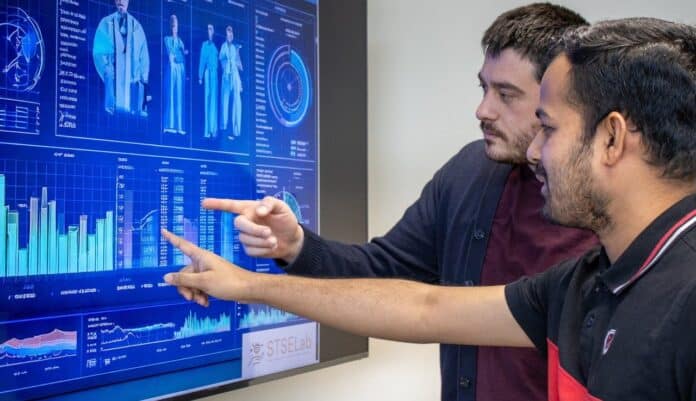Taylan Topcu is leading a team of Virginia Tech researchers using digital twins to help take better care of health care providers.
“We want to use the digital twin system to analytically predict the burnout trajectory and track a burnout inventory for physicians and nurses,” said Topcu, assistant professor in the Department of Industrial and Systems Engineering. “We would then be able to monitor these individuals and see if they are trending toward burnout and hopefully intervene proactively before it gets too overwhelming for them.”
A digital twin is a virtual replica of a real system that feeds off data collected from it in real time. Decisions can be tested for validity in the digital twin prior to their application in the real world. Topcu and his team plan to build such a system to recognize key indicators of providers’ needs and create strategies that prioritize of activities to benefit the well-being of both the providers and the patients.
“I am not a native health care systems researcher, so I decided to help address the issue of provider burnout at its core by leveraging my techniques that are more within the realm of my expertise, systems engineering,” Topcu said. “The current health care system prioritizes low-value administrative tasks over the mentally fulfilling aspects of medicine that are rooted in providing care.”
Described as a long-term stress reaction in the health care environment from things such as heavy workloads, time pressures, and emotional intensity, provider burnout can cause health care workers to feel emotionally and physically exhausted, unaccomplished, and can even lead to them quitting the profession entirely. According to a recent national study published by the Mayo Clinic, 45.2 percent of physicians reported at least one symptom of burnout in 2023.
With funding from the Institute for Society, Culture, and Environment’s Scholars program, the team is observing what primary care physicians in the Roanoke area are doing day to day. The analysis shows that the current health care system inevitably leads physicians to spend a vast majority of their time interacting with electronic health records rather than providing direct patient care.
“We looked at a number of things that they do and how long it takes to complete them, like reading and filing reports, treating patients, or reading lab results.” Topcu said. “However, these doctors and nurses are also human, so they are influenced by everything they experience throughout the day. They might hear a devastating story in the morning and must carry that with them through the rest of their shift and even after.”
Along with Topcu, the research team includes:
- Sarah Henrickson Parker, chair of health systems and implementation science at the Virginia Tech Carilion School of Medicine and associate professor at the Fralin Biomedical Research Institute at VTC
- Justin Price, associate professor at the Virginia Tech Carilion School of Medicine and a medical doctor
- John Epling, professor at the Virginia Tech Carilion School of Medicine and a medical doctor
- Md Doulotuzzaman Xames, a Ph.D. candidate studying industrial and systems engineering
Xames already has assisted Topcu in preliminary literature reviews and data analysis, one of which was recently published in the Institute of Electrical and Electronics Engineers Access Journal. He said it was the cross-disciplinary nature of the project that drew him to it.
“My involvement in this research stemmed from my strong interest in health care applications of engineering, a passion I share with Dr. Topcu, who introduced me to this project,” Xames said. “The most exciting aspect of this research is its potential to create a more sustainable and equitable health care system. Our research suggests that digital twins have the potential to enable proactive workload management, helping to alleviate provider burnout while enhancing operational efficiency and patient outcomes.”
The team’s research builds on work that resulted in two previous papers published in the Institute of Electrical and Electronics Engineers Access Journal. One paper, a systematic literature review, dives deeper into digital twin systems and the other highlights the team’s conceptual idea to implement the technology in the health care system.
As technology continues to develop, so do the processes and procedures of the health care system. While technological advancements are critical to the evolution of health care, doctors and nurses are frequently overlooked, yet their collaborations still remain the backbone to its success. Struggling to keep up with these advancements while still providing appropriate care to patients, can lead to provider burnout.
Although team members have run into some barriers, especially with access to health care data due to privacy regulations, they have still managed to extract beneficial information to help lay the foundation for these digital twin systems. Through their initial analysis of a small number of electronic health care records, Topcu and his team realized that the records do not capture key factors like physician fatigue and task satisfaction. To address this gap, the researchers will conduct surveys and interviews with health care professionals to build a more accurate digital twin system.
Looking ahead, the researchers plan to make this core idea a reality. The immediate goal of the team is to apply for funding from the National Institutes of Health, which will be crucial to support the next stage of this project – building a burnout prediction model prototype and also allow the team to implement the prototype into a real health care system, where they can then modify the digital twin to be both effective and sustainable.
Topcu said the long-term goal of the project is to rethink the health care system entirely. With a better understanding of the current health care system, the next step is to explore automation in ways that reduce physician workload while maintaining personalized patient care that can then be implemented locally, regionally, nationally, and beyond.
“This project serves as a springboard toward a more efficient, patient-centered, and sustainable health care system,” said Topcu. “By starting a new page, we can make a system that truly benefits everyone — patients, doctors, and nurses — because everyone is suffering in the current landscape. We created a monster, and it needs to be fixed somehow.”
By Becca Halm


